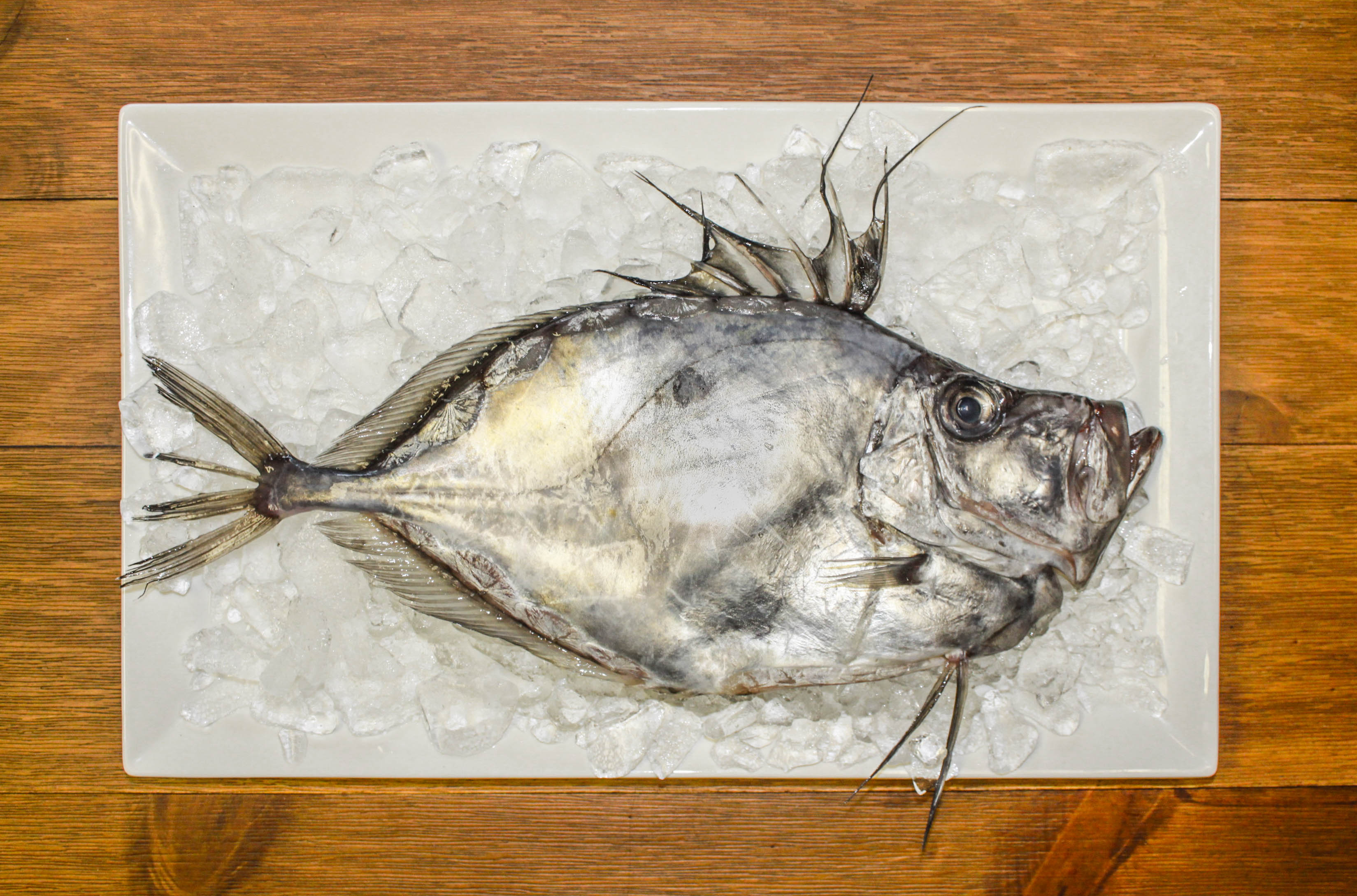
John Dory is often considered one of the ugliest fish in the world, with absolutely no relatives that we know of. It is an extremely thin, flat bodied, greyish-green fish, with an oval shape. It has 10 spines that run the length of the top of its body and has a signature ‘thumbprint” marking on each side. When we display whole John Dory in our retail store, it always inspires a lot of questions. So, we are here to educate you on this fish! Don’t be fooled by its looks; John Dory sure is tasty!
John Dory is found in the North Atlantic as well as cooler parts of the South Pacific, most commonly landed in the UK, Australia, and New Zealand. By comparison, Dover Sole, Bass, Grouper, Snapper, Emperor, and Halibut are all similar fish.
One of the most distinguishing features of John Dory are the large black dots on either side of their body. They are thought to confuse predators. Predators mistake the dots for eyes and aim for the Dory’s midsection instead of its real eyes. This misdirection gives the John Dory time to escape. The false eyes also have given John Dory another name: St. Peter’s Fish, in reference to a legend that states the black spots represent St. Peters fingerprint (hence “thumbprint” markings).
The best choice for preparation of John Dory depends on whether you’re purchasing a whole fish, or just the fillets. If you purchase just the fillets, your prep time is practically nothing. If you purchase the whole fish, plan about 15 minutes to remove the fillets. Buying a whole fish in general may seem daunting, let alone something that looks as odd as John Dory! But the filleting process is rather simple (Click here to find a how-to video on filleting a John Dory fish). Outside of preparation, there really is no “better way” to purchase John Dory, as either the pre-cut fillets or whole fish will taste amazing. It all comes down to whether or not you want the satisfaction of filleting the fish or not!
This fish is mild in taste and low in fat content. Its thin profile and large head make for a rather low fillet yield, coming in at around one-third of the fish’s body weight. This is why you don’t typically find them prepared whole. We suggest, sautéing, baking, frying, steaming, and poaching as the best ways to prepare John Dory. You may also include them in soups, stews, and bouillabaisse. Our one caution is: the fillets can be over-cooked easily, so beware!
John Dory really isn’t as intimidating as it may appear. Its taste alone is well worth the minimal time it takes to fillet the fish. Now that you understand what goes into preparing the fish to be cooked, stay tuned for tomorrow’s Facebook post on our suggested John Dory recipe! It’s one you won’t want to miss out on, that’s for sure!

John Dory is a delightful tasting white fish 🐠Is Harbor fish market a place where you can buy this fish
Hi John, it sure is! You can call our shipping dept at 207-775-0251, ext 2 to ask about having it shipped, or stop in to our store. 🙂
John Dorybis also caught off the East Coast of the USA, but it doesn’t have the dot.
Last week i was fishing off a wharf near Sydney Harbour Bridge and was reeling a very small undersized fish when suddenly i felt something bigger on the end of my line. I actually reeled in a john dory.. The john dory spat out the smaller fish when i reeled it onto the wharf . O didnt think john dory existed near the harbour bridge
Thanks for the story! Glad to hear from the great country of Australia!
I know my man Malcolm in Colorado would like to be booking a ticket to fly out for dinner. John Dory is on of his MOST favorite fish. Of course that fish will never make it to the market in Denver. Just as well not to spoil us mountain folks. Monica
We just moved from Manly Beach Australia. John Dory was our favorite fish there. I really hope we can get some here in the US. We will be calling Monday morning.
We are looking forward to hearing from you!
Do you still carry John Dory fish and can it be bought on line?
Unfortunately, we do not get John Dory very often and usually not a large enough amount to be put online.
Why is it so expensive and sought after? Certainly easily replaced in restaurants and labeled the same and less for the shop.
It’s comparable in price to a lot of our fish but part of it’s expense is due to the low yield of meat, it’s a skinny fish. It is very tasty with a sweet flavor and firm, succulent texture. Chef’s love to use it. Of course there is a wide variety of delicious white fleshed fish for less, your choice!